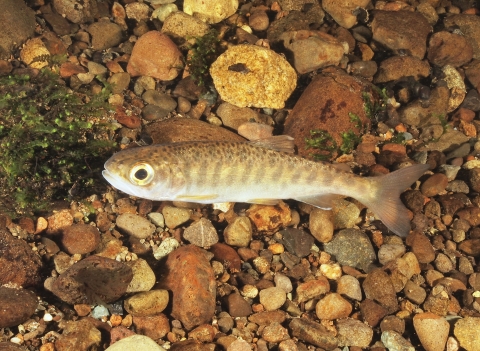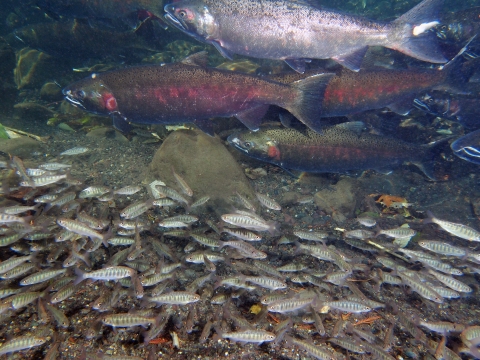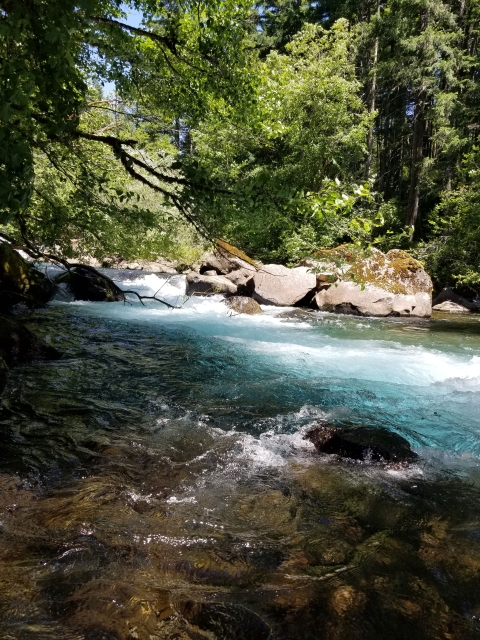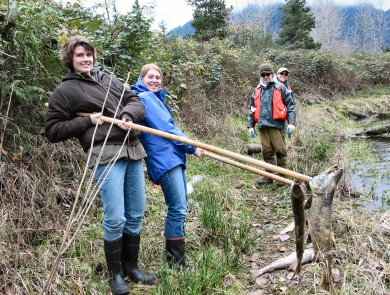Willard is a rearing facility only, adult salmon cannot make it back to the hatchery due to large waterfalls on the Little White Salmon River. The hatchery returns many more young salmon than would occur through natural spawning alone. Nearly one million salmon are returned to the Columbia River system yearly.
Currently the hatchery produces two million upriver bright fall Chinook salmon annually, released into the Little White Salmon River. The hatchery also raises up to 1.2 million coho salmon annually in partnership with the Yakama Nation. These fish are transferred to various acclimation sites in north central Washington where they are released.
About Us
Willard National Fish Hatchery is located on the Little White Salmon River, approximately five miles upstream from the Little White Salmon National Fish Hatchery. We are located above an impassable natural waterfall and migrating adult salmon are unable to reach the Willard facility. Adult fish are collected and spawned at the Little White Salmon facility and eggs are shipped to Willard to initiate fish production. The hatchery includes 80.10 acres of land and we are co-located with the U.S. Geological Survey's Columbia River Research Laboratory.
What We Do
As a rearing facility, we rear 2 million upriver bright fall Chinook annually and up to 1.2 million coho salmon annually in partnership with the Yakama Nation. We mitigate for the loss of salmon associated with hydroelectric projects on the Columbia River and also fulfill tribal trust responsibilities.
Our Organization
Our Species
Coho Salmon
Coho (or silver) salmon are powerfully built and can jump falls that most salmon cannot negotiate. They have small black spots on their backs and the upper lobe of the tail fin. The gums at the base of the teeth are white. Although sea-run coho have silver sides, spawning males develop bright red sides and greenish backs. Spawning females are paler. The jaws of the spawning males often become grotesquely hooked.
Most coho spend 18 months at sea, sticking to coastal waters, and return to their home streams at 3 years of age and 8 to 10 pounds. The fry spend over a year living in streams.
Upriver Bright Fall Chinook Salmon
Upriver Bright fall Chinook, as their name implies, retain their "bright" silvery ocean color for weeks after entering fresh water. Spawning males turn dark green with rose-pink flanks. Females may have a duller version of the males' colors, but some acquire a brassy sheen. All races of Chinook can be distinguished from other salmon by their gray gums and their tail fins, which have spots on both lobes.
Fall Chinook typically spend 3 1/2 to 4 1/2 years at sea, returning to fresh water as 4-5 year olds. In August and September fall Chinook migrate upriver, sometimes swimming 60 miles in a day. They spawn in October and November.
Fall upriver brights are presently the most abundant salmon in the Columbia River Basin, and numbers have been slowly increasing since the mid-1960s. This is mainly due to hatchery production, since little natural spawning habitat is left. Historically many fall Chinook used to spawn in the main river stem, and most of this habitat has been altered by dams.
Projects and Research
Willard rears up to one million coho salmon for the Yakama Nation and two million upriver bright fall Chinook salmon from the Little White Salmon NFH. These bright salmon are released directly into the Little White Salmon River at the hatchery.
Visit Us
We are open Monday - Friday 8:00 am - 3:30 pm. The best time to visit the Willard National Fish Hatchery is late spring through fall; fingerling fish are present year round. The hatchery is located on the banks of the wild and scenic Little White Salmon River. The deep blue-green water attracts recreationists of all levels; from class V kayaking rapids to a quiet picnic to enjoy the peaceful scenery - this river does not disappoint. Activities include: enjoying the mountain canyon scenery, picnicking, viewing salmon, bird watching, and self-guided hatchery tours.
Get Involved
Whether you want to further conservation, learn more about nature or share your love of the outdoors, you’ve come to the right place. National fish hatcheries provide many opportunities for you to help your community and fish and wildlife by doing what you love. National fish hatcheries partner with volunteers, youth groups, landowners, neighbors and residents of both urban and rural communities to make a lasting difference. There are opportunities for everyone to get involved!
We enjoy having visitors and volunteers at our hatchery. You can come watch the hatchery at work or learn how to lend a hand.
The hatcheries provide local individuals the opportunity to volunteer by assisting hatchery staff with fish production, light maintenance activities and special events. All volunteers compliment our hatchery programs and offer valuable support. To volunteer, contact cheri_anderson@fws.gov, or call Cheri at (509) 493-1730.








